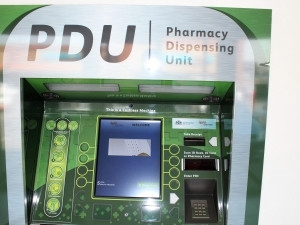
The Gauteng Department of Health is piloting the use of pharmacy dispensing unit (PDU) technology for patients with chronic conditions.
PDU is a healthcare innovation by Right e-Pharmacy, a subsidiary of EQUIP consortium partner Right to Care. Contributing pharmacy engineering and design expertise, Right e-Pharmacy collaborated with MACH4, a technology provider which customised the solution for SA, and German International Cooperation (GIZ).
The innovation received recognition at the first German Global Health Awards, held at the B20 Global Health Conference in Berlin last month. The award recognises innovations in the field of health for developing and emerging countries.
Dispensing efficiency
Fanie Hendriksz, MD of Right e-Pharmacy, says the PDU concept was born in 2010 with the intent of improving pharmacy service dispensing efficiency and delivery without deviating from quality of care.
"The journey from concept, planning, design and delivery of the first prototype took about three years," says Hendriksz. "The prototype was installed at the test site at Themba Lethu Clinic where the technology, software and user interfaces have been refined."
The first three sites will be at Alexandra Plaza, Ndofaya Mall and Bara Mall. These sites will primarily serve the chronic patients from public facilities in these areas, he notes.
The solution is the result of collaboration with multiple stakeholders - MACH4 as the only technology provider willing to customise a solution for SA; Right e-Pharmacy, which contributed the pharmacy engineering and design expertise; and GIZ South Africa.
Major funders of the three-year project are the German government and USAID.
"The Gauteng Department of Health understood the vision and is supporting the pilot of PDU technology at a pilot site soon to be launched at Alexandra Plaza, and with Soweto sites to follow," Hendriksz points out.
However, he notes the PDU is not yet commercially available. "The purpose of establishing the pilot sites is to determine and refine the operational stability and dispensing efficiency of the innovation in the context of a normal community setting or environment."
According to Hendriksz, the PDU is powered by a technology stack consisting of a user interface (the ATM), interacting with dispensing robots and other hardware components linked to a cloud-based database and a contact centre solution.
The hardware at the PDU site consists of the robotic component that stores, picks and dispenses the stock; the printer which prints and sticks labels onto each medicine item; the PDU user interface which is the part that looks like an ATM and with which the patient interacts with.
"All of the patient script information is kept in a secure cloud environment. This enables all PDU sites and the contact centre to access the patient data. The contact centre is then able to connect to the PDU via video-audio link to consult with the patient and oversee dispenses."
How it works
Hendriksz says people who are clinically stable and adherent to their prescribed chronic medication are identified at their clinic. If deemed eligible, based on the predetermined criteria, the clinic will inform the patient of the referral to the PDU site for chronic medicine collection, he explains.
"The patient's information and chronic medicine prescription is captured upon their first visit and they get registered using their ID books as proof of identification or supplied with a barcoded pharmacy card if they do not have an ID book.
"The patients then create and use a unique PIN to authenticate the medicine access using the ID/pharmacy card, like a bank card. The on-site support staff will facilitate and help familiarise the patient on the use or operation of the PDU. Once the patient has logged onto the PDU, they can talk to or interact with the pharmacy contact centre from where the prescription script will be captured or selected and authorised for dispensing under pharmacist supervision. At this point, the patient can have a consultation with the remotely-based pharmacist via video-audio linking if they have any questions."
Hendriksz adds the robot receives the instructions to supply (pick) and label the medicine from the pharmacist-authorised prescription and deposits it in the medicine collection bin of the PDU for the patient to retrieve.
Share